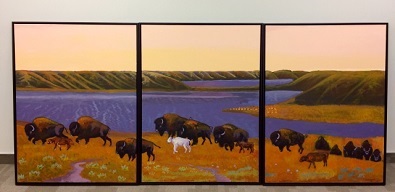Photo courtesy Saskatchewan Cancer Agency
Patients and visitors at the Allan Blair Cancer Centre may find inspiration in artwork, thanks to the efforts of Grade 11 and 12 students from the Ochapowace First Nation.
With the guidance of artist and Elder Michael Lonechild, students created a unique painting to provide a more welcoming experience for patients receiving treatment.
The piece consists of three canvases illustrating a herd of buffalo on the Prairies, and features a white buffalo calf, which is very rare. For many First Nations, the buffalo is a spiritual animal that often symbolizes strength and the ability to survive. The English title is Hope, Courage and Strength and it is called Wapi Paskwawi Moscosis (which means White Buffalo Calf) in Cree.
Dr. Jon Tonita is the Interim President and Chief Executive Officer of the Saskatchewan Cancer Agency and says the title of the artwork is very appropriate.
“All cancer patients rely on those attributes to help them along their cancer journey and it really turned out good,” said Tonita. “Their work will serve as a reminder that healthcare is about more than medical treatments; it needs to be inclusive of holistic care and that includes working with indigenous people to understand their needs and traditions.”
Ochapowace Chief Margaret Bear is proud of the work of her community’s young people in this initiative.
“These are our future leaders,” she said in a release. “And it’s encouraging to see how they came together to illustrate their message of hope for cancer patients who are undergoing treatment.”
Ochapowace initiated the artwork as a project through the First Nations and Métis Cancer Surveillance Program. The program was a three-year collaboration between the Saskatchewan Cancer Agency and the Federation of Sovereign Indigenous Nations to improve cancer control among Saskatchewan’s First Nations and Métis people within the healthcare system and gain insight into how to better serve these communities.
The program, which wrapped up this spring, started in 2014 and was funded through the Canadian Partnership Against Cancer. The Ochapowace First Nation was one of five participating communities, and focused on cancer awareness and prevention especially among youth.
